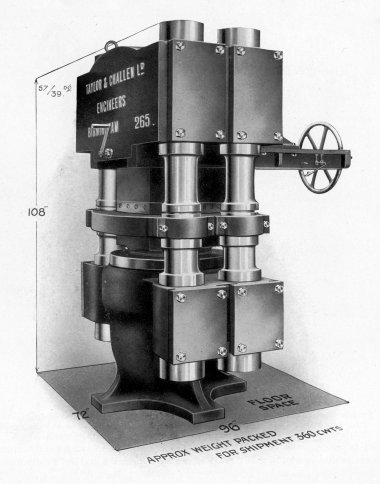Taylor & Challen Ltd
Engineers
Derwent Works
Constitution Hill
Birmingham
The images reproduced here were published by Taylor & Challen Ltd in their 1908 catalogue.

Gunpowder Mixing Machine, No. 4
Here the saltpetre, charcoal, and sulphur, usually in the proportion of 75, 15 and 10, are mixed be revolving the drum 40 revolutions per minute, and the flyers inside the drum at 120 revolutions.
Mixing goes on for about five minutes.
Gunpowder Incorporating Mills, No. 5
The gunpowder ingredients, after preliminary mixing, are here thoroughly incorporated together. Each charge of 50lb is carefully spread over mill bed, and is subjected to the rolling weight of the runners which is considerable. viz : – 4 tons each, for 3 hours. The movements of the runners are controlled by a friction clutch, which is worked by hand gear situated in a convenient position, so that the machine can be started and stopped at any time, and quickly.
Diameter of runners, 6ft.6. Width of runners, 1ft.3. Revolutions per minute 8
Gunpowder Breaking-Down Machine, No. 11
The mill cake from Incorporating Mill, No. 5, is here tipped into hopper shown at left hand and elevated above the breaking-down rollers, the top pair being fluted and the lower ones plain, the conjoint function of which rollers is to convert the pieces of cake into meal, in which state the boxes below receive same. For safety, the whole framework is solid gun-metal, so are also the gearing rollers, and exposed metal portions of the machine
Gunpowder Hydraulic Cake Presses, No. 6
The meal powder resulting from the breaking-down machine is now sandwiched between a number of copper plates contained in the press box shown in the illustration. The powder is now pressed into cakes, which measure 24in. square and 1/2in. thick or thereabouts. To facilitate the removal of finished cake, the overhead tackle is manipulated, and the heavy box is swung to a horizontal position, when the hinged sides of the box are opened and the finished cakes removed.
Between table, when down, and press head, 60in. Depth of press box, 2ft.9. Diameter of ram, 13in. Stroke, 20in. Cylinder of steel, press box of gun metal and oak.
Gunpowder Hydraulic Cake Press, No. 265
The gunpowder meal is here strickled off to required depth in a mould 24in. square. The movable top block is run into position and hydraulic pressure applied from below. The resulting cake is of particularly dense composition and about 1/2in. thick.
Cylinder is of steel, containing ram of 24in. diameter. Columns are 8 1/4in. diameter in smallest part. Pressure of water 2 1/4 tons per sq. in.
Gunpowder Granulating Machine, No. 234
In this machine the hard gunpowder cake, about 1/2 in. thick, resulting from treatment in the hydraulic press, is tipped into the lower hopper. Here it is broken into small pieces in the first pair of rollers, having coarse diamond-shaped teeth. From here it is raised in elevator shown to finer rolls at top, thence through other pairs of rolls of finer teeth.
The resultant grain is sifted in screen, which extends right under rollers, and which is constantly agitated by the action of the machine.
There are two grades of sieve in this screen, so that dust is separated from grain, and the chunks, which latter are passed through the machine again.
All frame is of gun metal, also gearing, and no metal part above floor is exposed except gun-metal or copper.
The mill is driven by bevel wheels on far side of machine, and rollers run at 25 revolutions per minute. 10 h.p. required to drive. Capacity, 1,000lbs. per day.
Gunpowder Dusting Reels and Glazing Barrels, No. 13
DUSTING. – The dusting reels are of two kinds: – 1st., slope reels. 2nd., horizontal reels. The grain powder from Granulating Mill, 234, is dusted in the slope reels (those in the illustration where the feeding hopper is at one end). A continuous supply of grain powder is thus allowed to pass through these revolving reels and empty by gravity into receptacles at lower end. The dust therefrom accumulates within the surrounding box.
THE GLAZING BARRELS, shown at front of illustration, now come into operation. The grain powder here, after hours of revolution varying 1-10, has imparted to it a fine glaze which the friction of grains rolling one over the other produces.
THE HORIZONTAL REELS (see illustration where the feeding hoppers are central), are used after the glazed powder has dried in the Drying Stove, No. 10, and impart a finish and colour to the grain. When the finishing dusting has been in operation an hour or so, the levers shown in illustration are manipulated and cause the reel to tilt at such an angle that the finished grains empty into receptacles at lowered end of reels.
8 h.p. required to drive above.







